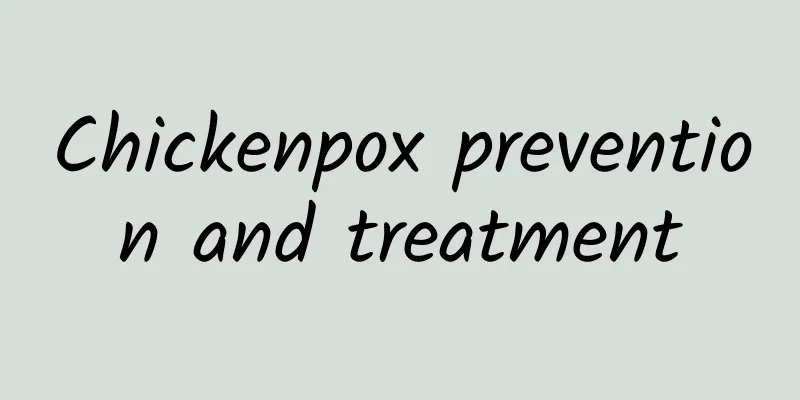Chickenpox prevention and treatment

|
Chickenpox prevention and treatment Chickenpox is a highly contagious childhood rash disease caused by the varicella-zoster virus (VZV). It is common in winter and spring. It is transmitted (infected) by droplets or contact, and long-lasting immunity can be obtained after infection. Common complications of chickenpox include skin infection, pneumonia, encephalitis, facial nerve paralysis, Reye syndrome, etc. Newborns, immunocompromised patients, and critically ill patients are at risk of death. 1. Pathogen and epidemiology The varicella virus has humans as its only natural host. The virus has weak resistance in vitro and is sensitive to heat, acid and various organic solvents and cannot survive in the scab. Varicella patients are the source of infection of varicella, and the transmission routes are droplets, direct contact with patients, or contact with items contaminated by patients' herpes serum. The general population is susceptible, mainly seen in children aged 2-6 years, and occasionally in adults. The incubation period is 10-21 days, usually about 14 days. About 90% of close contacts will develop the disease. The infectious period is from 1-2 days before the rash appears to the last skin lesion scabs and dry, about 7-8 days. It is recommended to isolate at least 10 days after the onset of the disease, and preferably isolate until 2 weeks after the onset of the disease. 2. Diagnosis points 1. Most patients have a clear history of contact, with an acute onset, and may have fever, loss of appetite, headache, abdominal pain, etc. Within 24 hours of onset, skin rashes or herpes the size of rice grains to peas appear in batches, followed by ulceration and scab formation. 2. Skin rashes are distributed centripetally (more on the trunk, followed by the head and face, and less on the limbs). The four generations of rashes coexist (i.e., macules, papules, herpes, and scabs coexist in one patient). Some mucous membranes are also often invaded, and skin rashes (or herpes) are seen in the mouth, throat, conjunctiva, vulva, anus, etc. 3. Laboratory examination: (1) The white blood cell count in a routine blood test is normal or slightly low, and the lymphocyte count is relatively increased. (2) Herpes scraping test: Take fresh herpes fluid for smear and stain with Wright stain to find megakaryocytes. (3) Varicella-zoster virus antibody test. (4). Virus isolation. 3. Key points of treatment 1. General treatment: change underwear frequently, cut the child's nails short, wear gloves to prevent scratch infection, maintain air circulation, eat light and easy-to-digest food, drink plenty of water, supplement vitamins (eat more vegetables and fruits), etc. 2. Drug treatment: Chickenpox is a self-limiting disease and can be treated symptomatically if there are no complications. (1) For skin itching without ulceration, calamine lotion or gentian violet solution can be applied topically. For ulceration, ethacridine solution or antibiotic ointment can be applied. For severe itching, a small amount of sedative can be given. (2) Antiviral treatment: Acyclovir is the first choice antiviral drug for the treatment of varicella. Some experts suggest that acyclovir should be used in children without complications, but routine use is not recommended. Some experts also suggest that it should be used as early as possible (within 48 hours of the appearance of skin rashes, oral acyclovir 20 mg/kg/time, 4 times a day, but the maximum single dose should be ≤800 mg/time. For patients with complications, immunosuppression, and severe cases, experts agree that intravenous administration should be used, 10-20 mg/kg/time, 3 times a day, for 7-10 days or until no new skin rashes appear for more than 48 hours. (3) Patients with bacterial infection can be treated with antibiotics. (4) Hormones are prohibited (current general consensus). 4. Prevention 1. Patients must be isolated and treated, and those with a clear diagnosis must fill out and submit an infectious disease report card in accordance with regulations. 2. Close contacts should be isolated, observed and quarantined for 3 weeks. 3. Carry out popular science education for the general public to enhance their awareness of disease prevention. 4. Vaccination with live attenuated varicella vaccine (vaccination is not recommended for immunodeficient/suppressed patients). 5. Close contacts can be given intramuscular injection of 2-4 ml of immunoglobulin or high-valent immune serum. |
<<: Tremella and cabbage can nourish yin and moisten dryness
>>: Food Safety | Do you like fried food? Heart disease also likes you!
Recommend
How long does it take from shallow immersion to full immersion?
When pregnancy begins, the babies in mothers'...
How to treat genital warts
The vulva is a kind of female reproductive organ....
Multiple cystic nodules of the breast, type 2
It is a very common phenomenon that women have no...
What to do if the pelvis becomes wider after childbirth? It is important to resume exercise
A woman's pelvis will be deformed after givin...
What is the effect of drinking black chicken soup on miscarriage?
Black chicken, also known as black-bone chicken, ...
Reasons for pregnant women to vomit yellow water
I don’t know if you have ever encountered this si...
What should women eat to prevent dark circles under their eyes? These foods are recommended
Due to various complex reasons, women are prone t...
What other tests are there after the four-dimensional
It is very hard for women to be pregnant for ten ...
The consequences of having sex during menstruation
People nowadays live very openly, especially in t...
Why do women experience frequent, urgent and painful urination?
Nowadays, female friends have many problems, such...
What causes ovarian dysfunction?
Premature ovarian failure is a relatively serious...
Will I definitely have withdrawal bleeding if I take birth control pills?
Taking birth control pills can easily lead to wit...
Diagnosing Epilepsy in Children - How Much Do You Know?
Author: Yuan Leilei, deputy chief physician, Beij...
Can common ovarian cysts cause abdominal pain?
Ovarian cysts are very common gynecological disea...
Feeling the signs of ectopic pregnancy
Speaking of ectopic pregnancy, I believe it is a ...









